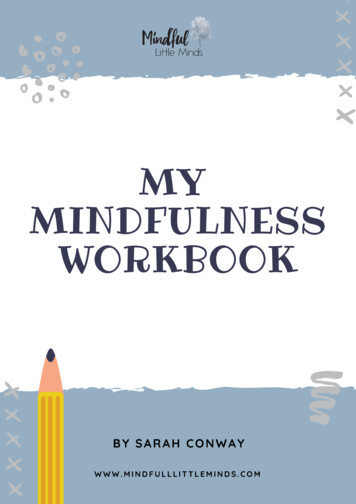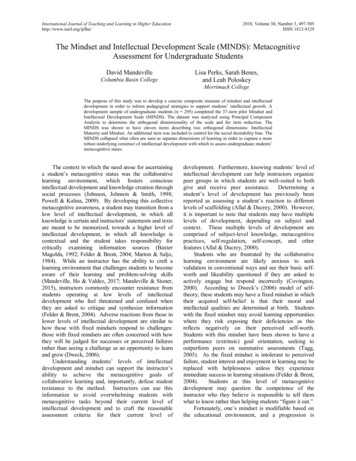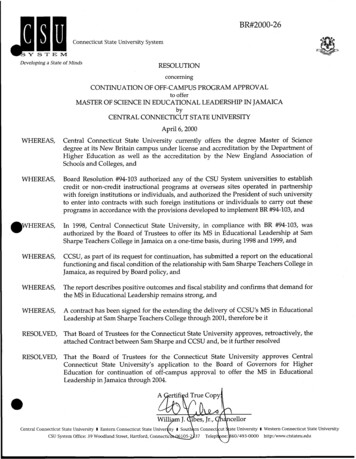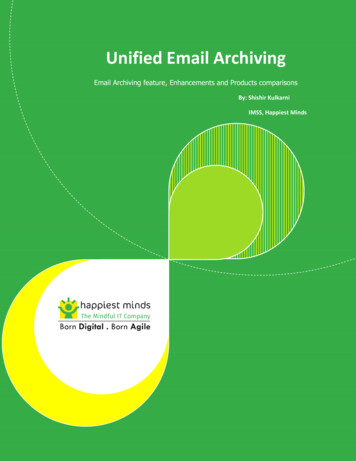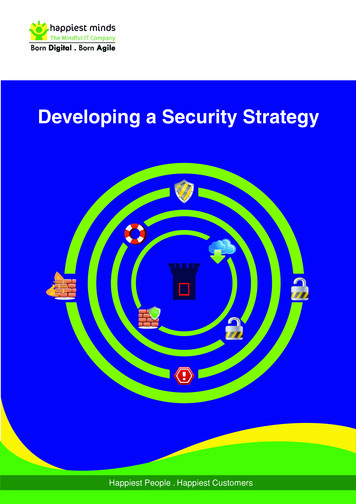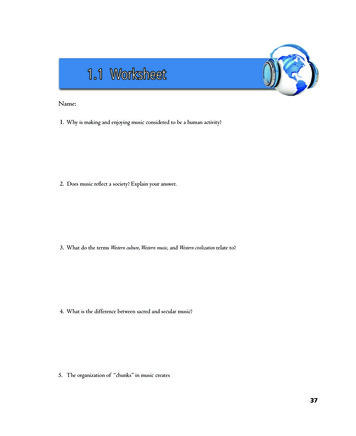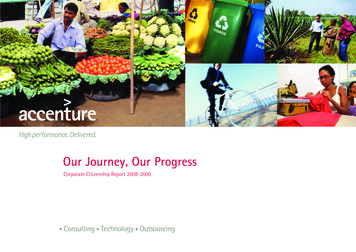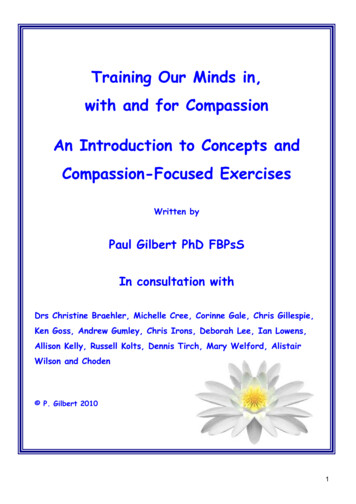
Transcription
Training Our Minds in,with and for CompassionAn Introduction to Concepts andCompassion-Focused ExercisesWritten byPaul Gilbert PhD FBPsSIn consultation withDrs Christine Braehler, Michelle Cree, Corinne Gale, Chris Gillespie,Ken Goss, Andrew Gumley, Chris Irons, Deborah Lee, Ian Lowens,Allison Kelly, Russell Kolts, Dennis Tirch, Mary Welford, AlistairWilson and Choden P. Gilbert 20101
ContentsSection OneTraining Our Minds in Compassion: The Basic Model and Principles.4Challenge number 1 - Dealing with our complex brains.4Challenge number 2 - Just finding ourselves here .8Understanding Motives and Emotions.9What about positive emotions? What functions do they have?. 11Some key questions for us to ponder . 12The importance of thinking. 12Emotional Learning and Body Memories . 13The Problems with Protection and Safety Strategies . 14The Three Circles Model: The Interactions between Different Types of Emotion . 161. Threat and Self-protection System:. 162. Incentive and Resource-seeking System . 173. Soothing and Contentment System: . 18Emotions about Emotions . 19Positive emotions can be difficult . 19Balancing our emotions .20The Many Parts of You . 20What is Compassion? . 22The attributes and qualities of compassion.22The skills of compassion .23Warmth and kindness .24How Will Teaching Myself to be Compassionate Help Me? . 26Fear of Compassion. 26How our Thoughts and Images Affect our Minds and Brains . 27The power of self-criticism.28The power of self-kindness .29Key Messages . 30Section TwoCompassion: The Exercises . 32Starting your practise.32Attention . 33Mindfulness . 34Mindfulness, attention and distraction.34Mindfulness and practise.36Mindfulness and consciousness.36Soothing Rhythm Breathing . 37Exercise 1: Soothing Rhythm Breathing .38Simple body scan and relaxation . 39Exercise 2: Simple body scan and relaxation.40Compassion Focused Imagery Work . 42Some key exercises.42Wandering mind .422
No clear pictures.42Safe place and compassionate colour imagery .43Exercise 3: Creating a Safe Place .43Exercise 4: Compassionate Colour(s) .44Developing the Compassionate Self. 44Recognising the different parts of you .44The compassionate self.45Exercise 5: The Compassionate Self .46Compassion under the duvet .47You at your best .47Exercise 6: Compassion Flowing Out.48Focusing the Compassionate Self . 48Exercise 7: Focusing the compassionate self on others.48Exercise 8: Compassion flowing into oneself: Using Memory.49Contrasting memories .49Exercise 9: Focusing the Compassionate Self on Yourself.50Exercise 10: Creating a Compassionate Ideal . 51The Skills of Compassion. 52Compassionate Attention, Thinking, Behaviour and Feeling.52Compassionate Thinking .53Changing self-criticism to compassionate self correction.55Distancing and Wise Observing .56Breaking identification with ones thoughts.57Compassionate Letter Writing . 58Compassionate self .59Compassionate image.60Guide to your letter writing. 61Getting started.62Recognising Emotions . 62Compassionate Behaviour . 65Practice and Practice Diaries . 65Fear of, and Blocks to, Compassion. 66Summary . 68Appendix . 70Worksheet for building your compassionate image. 71Compassion Focused Thought Balancing – Example Sheet .72Compassion Focused Thought Balancing.72Compassion Practice Diary – Example Sheet.75Compassion Practice Diary .76Recommended Reading and Further Information . 77Handouts . 793
Section OneTraining Our Minds in Compassion:The Basic Model and PrinciplesIntroductionThis booklet has been written for those who may be working individually with a compassion focusedtherapist or in a group. It can also be used by people who want to know more about the compassionfocused approach for helping with difficult emotions and tendencies to be self-critical. More detailedwriting on the compassion focused approach can be found in Paul Gilbert’s book ‘The CompassionateMind’. This booklet is split into two sections. The first section offers an outline of a basic approach tothinking about the nature of, and value of, developing compassion in our lives. The second sectionexplores some exercises that you can practise to try to stimulate your own compassionate mind.First we will outline the basic model and approach to compassion that we will be following. This willexplore how our brains work and what we mean by compassion. Now, of course, compassion traininghas been around for a long time, especially in Buddhist traditions, but here it is linked to some new ideasabout how our brains work. We are going to start by looking at a couple of challenges that life presentsus with and that we all experience.Challenge number 1 - Dealing with our complex brainsI think many of us ‘sort of realise’ that we have a very complex and difficult brain to deal with. Forexample, we know that many of our difficult emotions and much of our suffering occurs because of howwe feel in our bodies and in our minds. Most of us would rather feel happy than suffer and yet, eventhough we know it's our emotions and moods that are a source of our suffering, we can find it verydifficult to steer our emotions and moods to feeling happier.Now, there are many ways we can deal with this problem. One is just to carry on and hope that thingsimprove. Another is to try to understand our minds better and see if we can train them and cultivate themso that our unpleasant emotions are easier to regulate, and our positive and pleasant emotions areeasier to generate. A first step on this journey is to understand why our emotions can be so difficult andwhy this is not our fault. So let's begin to explore these questions. Now, one of the main reasons that wehave a difficult and complex brain with a range of powerful emotions and urges is because of the way4
our bodies and brains have evolved over many millions of years. For example, think about physicalpain. We can experience pain if we get a headache, break a leg, or suffer from some major illness.Pain is part of our body’s natural defence systems – it is there to alert us to things that might be wrong inthe body that we need to pay attention to. Our capacit
Compassion-Focused Exercises Written by Paul Gilbert PhD FBPsS In consultation with Drs Christine Braehler, Michelle Cree, Corinne Gale, Chris Gillespie, Ken Goss, Andrew Gumley, Chris Irons, Deborah Lee, Ian Lowens, Allison Kelly, Russell Kolts, Dennis Tirch, File Size: 957KBPage Count: 82Explore furtherCompassionate Mindwww.compassionatemind.co.uk16 Compassion Focused Therapy Training Exercises and .positivepsychology.comCompassion-Focused Therapy: What is it and who is it for?welldoing.orgCompassion Formulation Worksheetpositivepsychology.comWhat Is Compassion Focused Therapy (CFT)? - Psychology Toolswww.psychologytools.comRecommended to you based on what's popular Feedback



